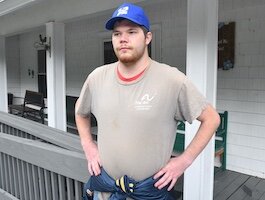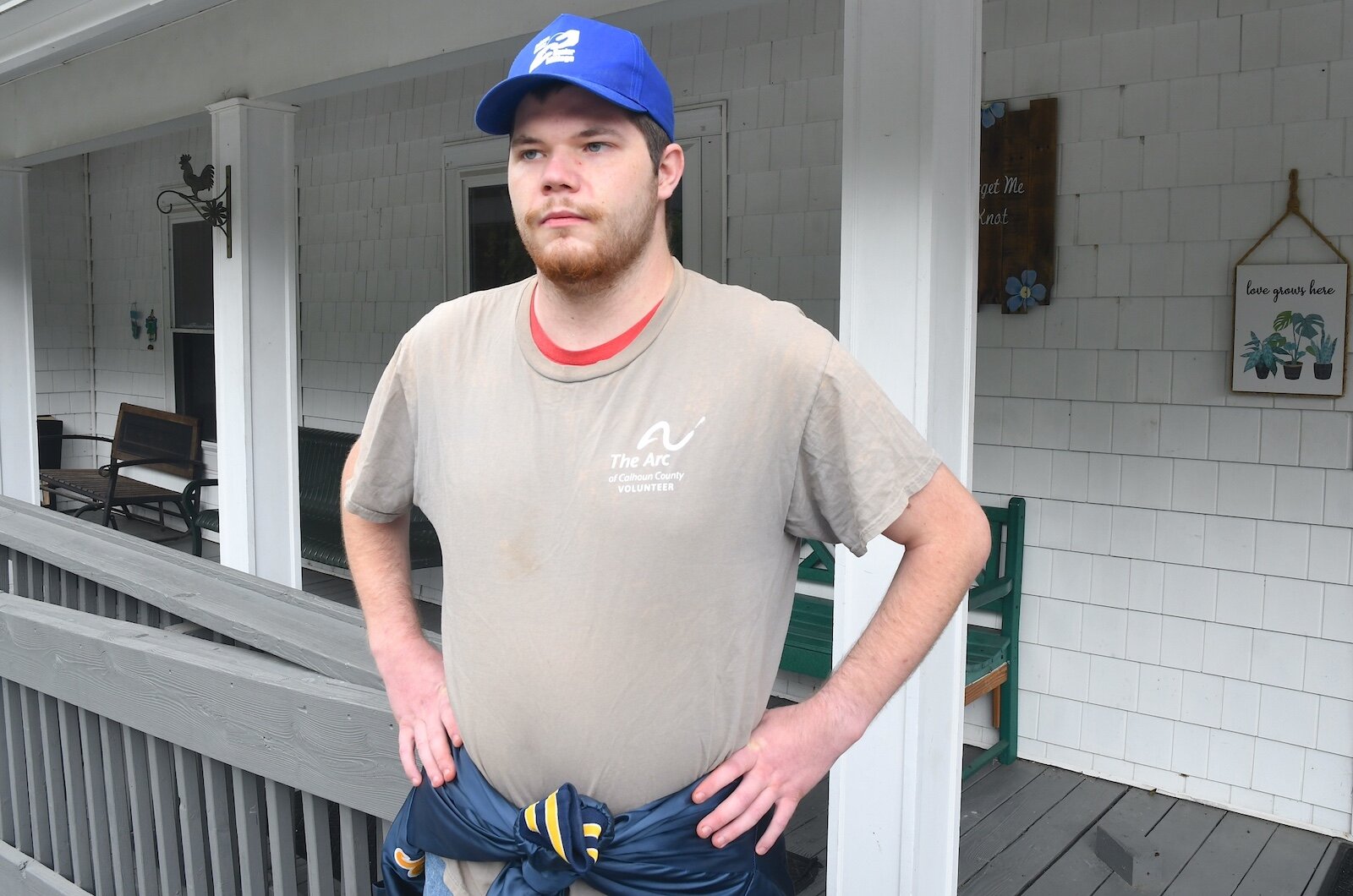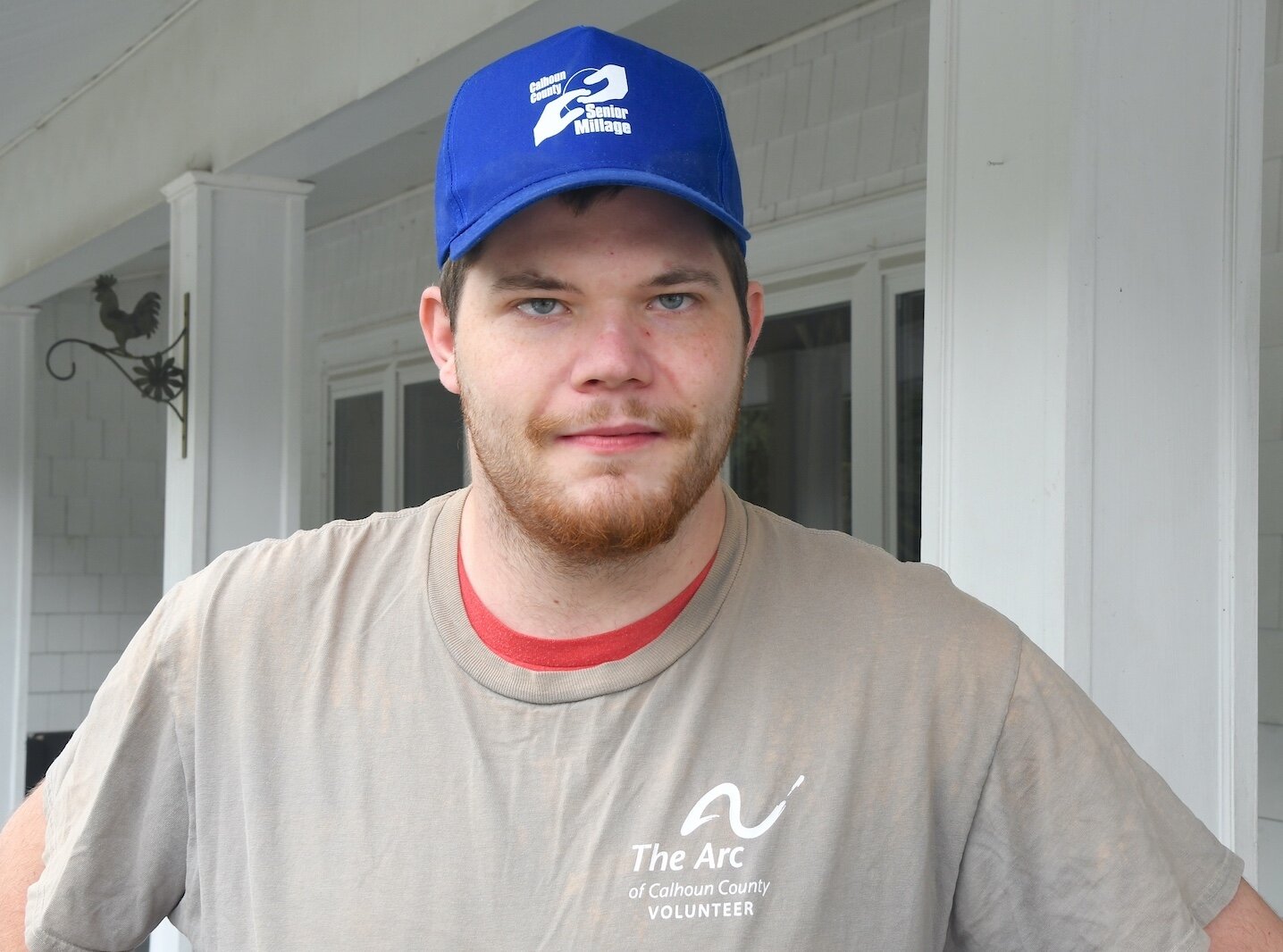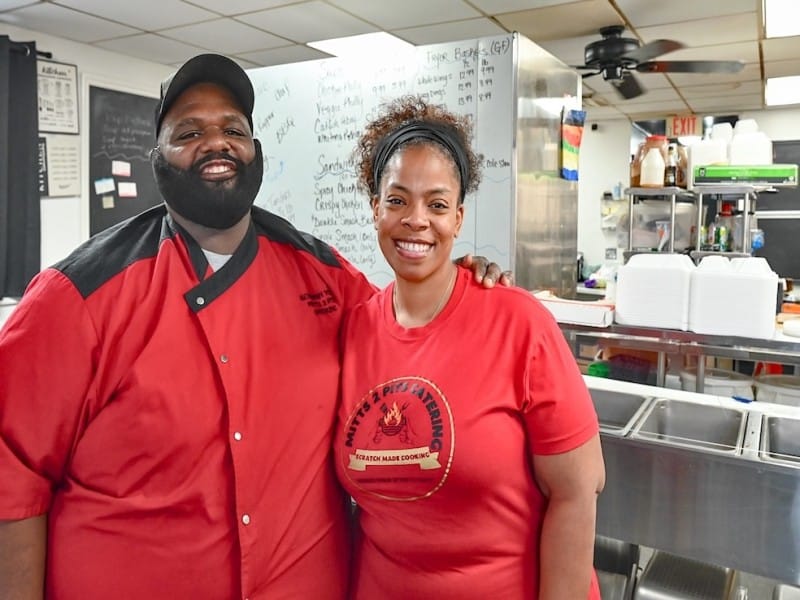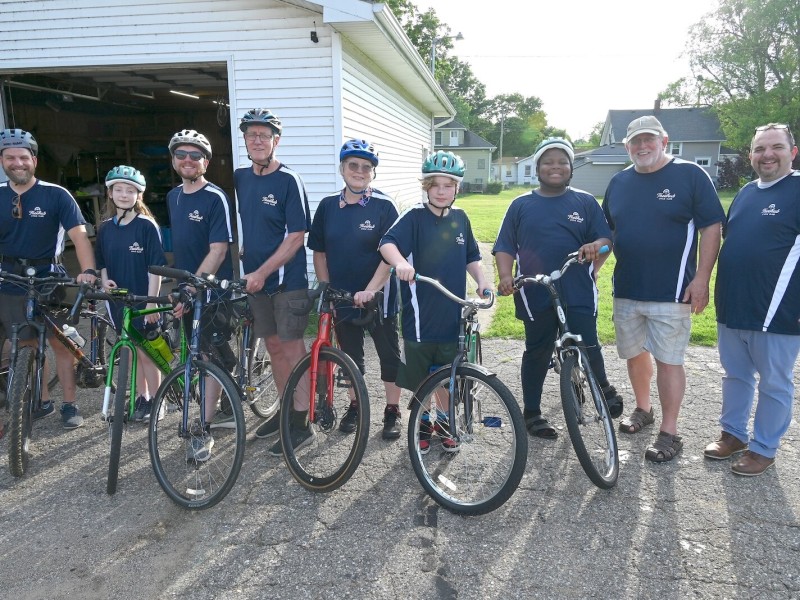Editor’s note: This story is part of Southwest Michigan Second Wave’s On the Ground Calhoun County series.
Aaron Darling is at a point in his life when he could be working a fulltime job and earning enough money to live comfortably on his own.
The current reality for the 27-year-old Battle Creek resident is that he lives with his parents, does occasional work that pays him $20 a day and volunteers with the ARC of Calhoun County.
“I’m not able to support myself or rely on myself and without social security and my parents I’m going to plummet,” says Darling who is a person with autism and who also has been diagnosed with Attention Deficit Hyperactive Disorder (ADHD) and a “few other things. I’m also flat-footed so that’s a disability, but that doesn’t slow me down. With some of those areas that I’m affected in I’ve only become stronger.”
Those disabilities have not stopped him from applying for jobs. However, they have prevented prospective employers from hiring him. For six years, he has been putting in applications, mostly at fast-food and retail businesses.
“I really like helping people, so if I can make a burger and see a little kid smile when I hand it to them it just makes me happy. When someone says thank you and they mean it, my heart just feels great,” he says.
However, he has yet to get this opportunity.
“Everyone I’ve tried says, ‘Sorry, we can’t use you.’ They never tell me why,” Darling says. “They just end the call and I’m just left in the dark. I have in-person interviews and they don’t call me back. I’ve tried so hard and I’m sure a lot of other disabled people get shot down. Why, because we’re different? That’s not a good reason. Disabled people all over the world can do what people think we can’t do, even in small ways because small things add up.”
His reality is becoming all too common for 22,555 individuals like him in Calhoun County who are living at or below the federal poverty level and are being marginalized, overlooked, and labeled because of the physical or mental disabilities they are living with.
What they’re experiencing has been documented in a report released at the end of July by the United Way of South Central Michigan (UWSCMI) titled “Alice in Focus: People with Disabilities”, based on data collected in 2019.
The analysis of 2019 data looks specifically at individuals with disabilities who live in poverty or are Asset Limited, Income Constrained and Employed (ALICE). ALICE households earn more than the Federal Poverty Level but less than what it costs to live and work in the modern economy. Statewide, 48% of people with physical, mental or emotional disabilities—more than 657,000 people—live below the ALICE Threshold, meaning they earn less than what’s needed to be financially stable.
The Federal Poverty level for an individual or one-person household is $13,590, according to the website HelpAdvisor.com. The ALICE threshold is $12,880.
One hundred percent of the adults served by the ARC of Calhoun County fall at or below the ALICE threshold, says Leah Ortiz. She is Executive Director of the ARC, which offers programs designed for skill building and supported employment to individuals with disabilities.
“The reality is that this one report is not going to change decades of reports,” Ortiz says. “We have known for many years that individuals with disabilities are underemployed and their income levels are extremely low. This is not something new.”
Looking at Michigan’s labor force numbers for 2021, she says that 19.1 percent of persons with disabilities were unemployed, an increase from 17.9 percent in 2020. At the same time, 63.7 of individuals with no disabilities had jobs.
Ortiz says these numbers continue to shock her. Despite the huge gaps, she says the approach “has never changed on how we truly wage war on these disparities.”
UWSCMI’s region includes Calhoun, Clinton, Eaton, Ingham, Jackson, and Kalamazoo counties; this report also includes Barry County because it’s combined with Calhoun County under the U.S. Census Bureau’s American Community Survey Public Use Microdata Samples, on which the ALICE analysis is based.
Income eligibility for federal Supplemental Security Income (SSI) is nearly four decades out of date, shutting out many people from a much-needed financial lifeline, says Alyssa Stewart, Chief Impact Officer for UWSCMI, adding that “Using ALICE data that takes into account the actual cost of living would go a long way towards supports addressing the issues this data highlights.”
According to the report, 46% of Michigan residents with disabilities below the ALICE Threshold did not receive SSI. The program requires that recipients have income below the poverty level, be unable to work, have a “severe” impairment, and have less than $2,000 in their bank accounts, or $3,000 if they are a married couple.
Other statewide findings from the report:
• Black and Hispanic residents with disabilities — 65% and 54%, respectively — disproportionately experienced financial hardship compared to 43% of white people with disabilities.
• Females with disabilities struggled more to afford the basics — 51% — compared to 44% of males with disabilities.
• Among Michigan residents with disabilities who own a home, 84% are house burdened, meaning they spend 35% or more of their income on their mortgage, plus utilities, taxes, and insurance. For renters with disabilities, 93% are rent burdened, with 35% or more of income going to rental costs.
• Whether working full- or part-time, people with disabilities were more likely to be living paycheck to paycheck than those without disabilities: 21% of full-time workers with disabilities were below the ALICE Threshold compared to 16% of full-time workers without disabilities. For part-timers, 53% of those with disabilities were below the ALICE Threshold, while 36% without disabilities fell below that level.
“The Federal government has made it difficult while trying to make it easier for people with disabilities to work,” Ortiz says. “If they work a certain amount while receiving benefits, it could impact those benefits. If they lose Medicaid or Medicare, they are forced to seek out their own healthcare plan and have exorbitant co-pays and out-of-network costs, they aren’t able to be financially independent. There’s a fine line between work and benefits and living successful, independent lives.”
Because no one solution will fix this puzzle, Ortiz says she continues to attempt to create public policy with state lawmakers.
“Many components need changing and updating and people with disabilities need to be part of the conversation,” she says. “I work with people in Lansing and try to appeal to legislators about these changes. People with disabilities are a low priority for the government with policy changes.”
“At this point, we’re in an awareness-building stage and sharing the data widely with the community at large, corporate and nonprofit partners,” Stewart says. “We’re collaborating with the Disability Network of Southwest Michigan to have community conversations. We recently completed a 21 Day Disability Equity Challenge where we gathered content from individuals to gain a better understanding of issues in the disability equity space. We hope this will be used to create change and a better awareness for service providers and their call to action ensuring that the services they’re providing are as accessible as possible for individuals with all types of disabilities.”
Stewart says the report shows that employment rates for people with disabilities are lower which means “they aren’t able to participate in the labor force as actively and get lower wages and part-time work. This creates a barrier for folks with disabilities.”
She says many employers don’t realize how many folks already in the workforce identify as having disabilities.
“Twenty-five percent of the total U.S. workforce is people who identify as having disabilities,” she says. “I think one of the biggest opportunities is in the employment space and really working with employers to create equitable employment opportunities for individuals with disabilities. A lot of employers are unintentionally preventing folks from accessing jobs with them. Changes in policies and procedures would make a big difference in equity in employment. Inclusive means individuals with disabilities will truly be included.”
Individuals first
Darling says individuals with disabilities are “individuals who deserve to be given the same employment opportunities as people without disabilities. I have tried to find work at businesses and they haven’t even given me a chance. That’s their loss. Disabled people have a lot to give if only you give us a chance. We’d be a major part of the U.S. workforce if they only give us a chance.”
The ALICE report highlights a workforce opportunity that has gone largely unnoticed, says Yvonne Fleener, CEO of the Disability Network of Southwest Michigan. The network has an office in Battle Creek that provides resources and services to individuals with disabilities. She says almost everyone, if not everyone receiving services through the Disability Network, is below the ALICE threshold or hovering at the ALICE threshold.
“There needs to be greater awareness of our communities,” she says. “There’s such a great need and potential when we have people looking for employees and we have a group of people who can’t find work at a rate of three times higher than those with no disability. How do we go about doing that skill building, teaching the soft skills, and prepping them to go work those jobs that are available?”
The ARC offers programs designed for skill building and supported employment, but Ortiz says employers need to give her clients a chance to show what they can do.
“October is National Employment Awareness Disability Month. It’s interesting because the Americans with Disabilities Act (ADA) prevents an employer from discriminating on the job,” Ortiz says. “They are mandated to provide accommodations and accountability. There are protections in place if you can prove that you’re not being hired because of a disability. It’s really easy for employers to get around that. We’re trying to break down the bias that surrounds individuals first and foremost as a barrier to employment.”
While she says she doesn’t think the ALICE report is going to lead to a lot of wholesale changes, Ortiz says she is going to put an increased focus on reaching out to employers to urge them to hire the people served by the ARC.
“The biggest message in all of this is to stop labeling people and assuming what they can and can’t do based on a label,” she says. “Stop judging, assuming, and labeling.”
Fleener says there is growing interest in enacting policy within organizations like hers around building wealth. She says asset policies have not changed in 30 years.
“We see people every day who come in for referral services. We do some specialization work like benefits planning to help people or to help them get their benefits,” Fleener says.
A few weeks ago, she met with a man who was homeless, found a place to stay, and then was facing homelessness again.
“It’s really challenging for people to get out of that threshold. It’s difficult to build wealth if you receive federal benefits because there are limitations on assets,” Fleener says. “We’re seeing people struggling financially and then you add in the disabilities and it becomes much worse. We have people coming in every day to get bus passes and gas cards because they don’t have the money to cover costs like these.”
The Disability Network staff works with them on budgeting and talks to them about other resources available to them. Fleener says 40 percent of the people who come in are eligible for Supplemental Nutrition Assistance Program (SNAP) benefits but have not applied for it.
“We connect people to all different resources in our community so they can at least maintain some stability while trying to find housing and employment. It’s a challenging problem,” Fleener says. “The people we see are people who are seeking work, housing, or help with paying their bills because they’re not making ends meet. The burden is heavy. Our staff doesn’t go home and stop thinking about the people they know who don’t have a place to sleep at night.”
Although they don’t turn people away, Fleener and Ortiz say they are in need of additional funding to meet a growing demand for their services.
“We have a very finite donor base,” Ortiz says.
Through the United Way, the Disability Network has an emergency fund to help people that is intended to last through July 2023, but Fleener says one-third of those funds have already been used up. And Fleener doesn’t think the remaining funds will see them through the remainder of the fiscal year.
“The needs keep growing in our communities,” she says.
Sandy Hopkins, 67, who lives in Battle Creek says it’s a question of fairness. She was diagnosed in 2005 with bipolar disorder and schizophrenia and says she would like to find a part-time job to supplement her social security benefits. She says the ARC has helped her prepare to look for work, but she knows that she is looked down upon because of her disabilities
“It makes me feel frustrated,” Hopkins says. “It’s about me as an individual and not my condition. We need to be looked at like individuals and not be given labels.”
When automatic assumptions are made about individuals with disabilities, Ortiz says capability and capacity almost always come into play.
“If you see a person walking down the street walking differently than you, how many people will make assumptions about their capacity and what they’re capable of doing,” Ortiz says. “Many disabilities don’t have physical characteristics. You may have feelings of empathy for someone and have no idea what they’re capable of.”
Reducing these biases is critical, she says.
“There just needs to be that awareness that having a disability isn’t a deficit, it’s diversity,” Fleener says. “We need to recognize that all of us are going to be part of the disability landscape in one way or another, whether it be physical changes related to aging or a life-changing event that results in a disability.”
Speaking as a member of the disabled community, Darling offers a simple and straightforward message: “Don’t give up on the disabled. We want to have the opportunity to work. Working a full shift in a safe environment would be the greatest thing in my life. My sisters, brothers, and parents have all given me so much. I’d like to give back. To everyone out there who is disabled or thinks they are disabled, it’s not the end of the line. Keep pushing and lean on others to support you. We’re disabled, come find us.”

